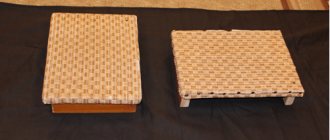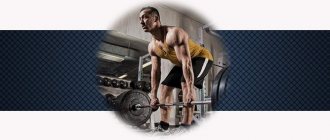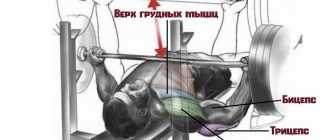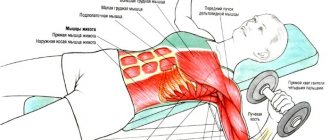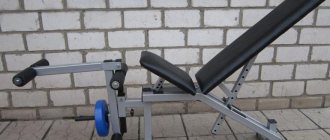The bench press is a basic exercise that uses a large number of muscles in the body.
Depending on the characteristics of the technique of performing the movement, you can shift the load on one or another muscle. Surely you know that this is not only a great exercise for gaining mass and increasing strength, but is also competitive in powerlifting. We also note that the inherent variability of the bench press is not found in any other strength exercise. You can perform it with different positions of your arms, body, and legs. There are many variations of this exercise, and calling them the same thing is quite difficult. However, despite the high popularity and effectiveness of the movement, sometimes athletes are faced with the question of how to replace the bench press at home? This is exactly what we will talk about today. However, first I would like to touch on the topic of macro cycles in the training process. The annual training plan of any athlete can be divided into three stages:
- Increase in power parameters.
- Mass gain.
- Work on the relief.
All this is well known, but I still want to remind you that cycling allows you to achieve high results in sports.
When do you have to look for an alternative to the bench press?
Let's look at the two most common situations in which athletes begin to wonder how to replace the bench press at home?
Injury
Most often, athletes have to look for a replacement for one or another exercise due to injury. Moreover, it does not necessarily have to be received recently, because chronic injuries are also common and periodically make themselves felt. Unfortunately, many bodybuilders do not treat chronic injuries as responsibly as they should. As a result, they cause serious harm to themselves.
If you are injured or an old one is making itself known, then there is no need to torment your body. In addition, if you feel discomfort during the exercise, you will not be able to fully use the full power potential of the muscles and, as a result, will not get the desired effect. In the worst case scenario, the situation will worsen and you may even suffer new damage. If you have an injury, then it is definitely worth thinking about what to replace the bench press with at home?
Muscle feeling
Some athletes cannot feel the muscles contract when performing a bench press. This is most often due to the structural features of the skeleton, as well as the composition of the muscles. Perhaps your triceps or deltoids are inferior in development and tire quickly compared to the chest muscles. The opposite situation is also possible, in which the entire load falls on the stronger muscles, while the pectoral muscles practically do not work.
During a strength training cycle, we recommend following Mike Mentzer's advice and using pre-exhaustion of the target muscles. When it comes to the chest, you must first work out the small muscles. Otherwise, you should first fatigue the triceps or deltoids in order to achieve failure of the pectoral muscles. During the mass-gaining period, you can even use special exercises.
Why replace the bench press?
Injuries: a common reason for replacing various exercises, and the injury does not have to be fresh, it can also be chronic, when the athlete cannot normally innervate the muscles in one position or another. Unfortunately, people often neglect this reason, continuing to persist and only causing harm to themselves! The presence of an injury is a good reason to exclude an exercise from your training program. If the injury is fresh, then it is best to leave it alone and let it heal; if the injury is chronic, then even then there is no point in “tormenting the pussy”! On the one hand, since it is not convenient for you to perform the exercise, you will never be able to realize the strength potential of your muscles in your life, and, as a result, the exercise will be useless. On the other hand, you will either interfere with the healing of the injury, or, by squirming under the barbell, contribute to the appearance of a new one. Conclusion: if the exercise is painful or uncomfortable for you, you need to replace it with something!
Muscle Feel: Many people do not feel their chest when performing a bench press due to skeletal structure and muscle composition. Either the triceps and deltoids are much weaker, so they tire earlier than the chest, or they are much stronger, so the press is performed by the deltoids and triceps, and the chest is practically not included. During the strength period, it is necessary to use preliminary fatigue, as Mike Mentzer bequeathed, and if the chest falls out, then it is necessary to first fatigue small muscle groups, and if the triceps and deltoids fall out, then fatigue the chest so that “failure” occurs primarily in the chest. While gaining mass, the bench press can be replaced with more specific exercises.
What exercises can replace the bench press?
Above we looked at two reasons why the question arises: how to replace the bench press at home?
However, not everyone has a barbell at home, and it is the absence of this equipment that can lead to a similar question. Let us remind you that the classic movement is primarily intended to pump up the chest muscles. At the same time, its variations can shift the emphasis to the deltoids or triceps. To perform this movement, you will need the following sports equipment:
- Directly the barbell.
- Bench.
- Racks on which sports equipment is located.
- Companion for safety net.
This is where the difficulty of performing the movement at home lies. However, it’s time to answer the main question of the article - how to replace the bench press at home?
Push ups
In essence, the bench press is a more complicated version of push-ups. Moreover, both movements are extremely rare in real life. Remember when you had to push off the ground or lift an object while lying on your back? At the same time, the exercises imitate the natural movement of pushing someone or something away from you.
It is quite common in everyday life, and it is easier to train it in the horizontal plane. Since the barbell was not invented right away, people started using push-ups. If you have not played sports before, then this is the movement you should start training with. If you are not able to do 15 push-ups or more. Then you don’t need to start pressing.
If your training program involves performing bench presses for, say, three sets of ten reps each, you can safely replace the exercise with push-ups. Work for the required number of sets, performing the movements to failure. As a result, the effect will be higher compared to bench presses with an empty bar. Once this movement no longer increases strength, but only increases endurance, you can move on to the bench press. However, you shouldn’t give up push-ups in such a situation, because this is one of the most effective strength movements.
Undoubtedly. In the situation discussed just above, you have to complicate the classic push-ups. Our muscles don't care what you want to load them with. The only thing that matters is the time spent under load and its degree. We also remind you that the load should gradually increase. Only in such a situation can progress be made. There are a lot of options for making push-ups more difficult, and you don’t even have to do barbell presses, but still build good muscles.
Here are some popular ways to complicate the classic exercise:
- Place your feet on a support to shift your body weight to your upper body.
- Increase the range of motion by resting your hands not on the ground, but on the support. For example, a stack of books.
- Do plyometric push-ups. To put it simply, do push-ups with a clap, change hands, etc.
- Shift your body weight onto one hand. As a result, proceed to performing push-ups on one arm.
- Perform the exercise with additional weights.
- Combine the methods discussed above.
Dips
Well-known among bodybuilding fans, John McCallum believes that this exercise is the second most important for an athlete, after breathing squats. This suggests that he ranks dips even higher than the bench press itself. Some athletes will think that it will be even more difficult to find parallel bars at home than a barbell. This is absolutely not true, because instead of this sports equipment you can use two chairs with backs or any surfaces located at the level of the pelvis and above.
Dumbbell bench press
By the way, some bodybuilders prefer working with dumbbells to a barbell, even if they can perform a classic bench press. This is due to two main factors:
- The dumbbell press is more difficult to perform, as additional effort must be made to hold the exercise equipment.
- The joints experience less stress, which minimizes the risk of injury. When working with dumbbells, the hand moves along a natural trajectory, and the shoulder joints suffer less.
We do not want to say that the barbell press is an extremely harmful exercise, but some scientists are confident that working with dumbbells is still safer. We can agree with this, at least from the point of view that dumbbells will not be able to press down on the chest. If you don’t have a bench press at home, which is most often the case, you can do the exercise while lying on the floor. However, this does not allow you to work with full amplitude, but this problem can be eliminated with the help of a fitball.
One-arm dumbbell presses in a lying position
Actually, this is a variation of the previous movement. It is worth using it if the weight of your collapsible dumbbells is no longer enough to perform the movement to failure. The way out of this situation is obvious - place the weights on one dumbbell and press it with one hand.
Barbell floor press
If you don't have a bench press or racks at home, you can do the classic bench press on the floor. However, you will need a chair on which to first place the barbell. I would also like to say that this option is quite dangerous, and it is better to choose one of the methods discussed above.
Bench press analogs
In strength sports, exercises are divided into isolating and basic. The difference is that basic movements involve several joints, while isolating movements involve only one. The bench press is a multi-joint exercise, which means that a substitute should be chosen from among the basic exercises for the muscles of the thoracic region. It is undesirable to use an isolating exercise as a substitute, because the effect from it will be inferior in many respects. A single-joint exercise is included only when it is not possible to find a basic analogue of the bench press.
Multi-joint analogues of the bench press are as follows: push-ups with wide arms, bench press of dumbbells and barbells at different angles, push-ups on uneven bars. It is believed that the most suitable alternative to the flat bench press is the incline dumbbell press. This is due to a more amplitude of movement and the development of small stabilizing muscles.
Using parallel bars in the training process is also very effective. It is worth noting that in order for the main emphasis to fall on the chest muscles, it is necessary to move the body forward when performing this exercise. This will remove some of the work from the triceps and redirect it to the chest area. More efficient pumping will be ensured by using additional weight.
When exercising at home, you can develop bundles of pectoral muscles using push-ups from the floor, but just be sure to place your arms wide and have weights. It is also necessary to place your feet on some kind of elevation, which will allow you to work out different thoracic regions.
How to properly perform a dumbbell press while lying on the floor?
Let's look at the technique of performing dumbbell presses on the floor if you don't have a bench.
If you train at home, then this is an excellent alternative to the classic exercise. It can perfectly work the mid-chest and triceps. If you want to additionally ensure maximum stretching of the chest muscles, then you should perform bench presses on a fitball. Here are the rules for performing this exercise:
- Take a comfortable position lying on your back, bending your knees and resting your heels on the ground. It is advisable that the surface is not too hard or too soft.
- Take the shells in your hands and spread them to the sides, slightly bending your elbow joints. In this case, the shoulders rest on the ground, and the forearms are located in a vertical plane.
- Start squeezing the dumbbells until your arms are fully straightened, pausing at the top point of the trajectory for a couple of seconds. While moving to the starting position, your muscles should remain tense.
- After completing the required number of repetitions, pause to recover and move on to the next set.
Let us remind you that your feet should be in the most stable position possible, and your back and buttocks should be pressed firmly to the ground.
You can also use variations of the movement we discussed. Let's say that in the initial position the projectiles are located parallel to each other, and during the upward movement they smoothly turn around and at the top point of the trajectory are already on the same line. All the exercises we have considered can work out the pectoral muscles well. Most often, when training at home, athletes do not pursue serious goals, but simply want to get their body in order. Regular exercises will help you solve the problem. Of course, it’s good when you have the opportunity to purchase a barbell, racks for it and a bench. This will expand the list of available movements. However, even working with dumbbells alone, you can achieve good results. The main thing is desire and regular training with properly organized nutrition.
More information on whether push-ups can replace the bench press:
Iron Health
Training a beginner athlete differs from training an athlete of an intermediate level. As a rule, beginners, when they come to the gym, begin to greedily grab at all the basic exercises, without thinking about technique and their actual level of training. Therefore, in the initial stages of bodybuilding (as well as powerlifting), many novice athletes experience some disappointment from the gym - they say, I work out a lot and do the same exercises as the “bulls,” but the progress is almost imperceptible.
Let's take the bench press as an example. It would seem that there is nothing complicated in this exercise. However, due to poor muscle development and ignorance of the correct technique, the effectiveness of presses becomes almost zero. There have been cases when trainers of “that generation” forced beginners to do dumbbell presses, explaining that this way they would learn to bench press faster. How can you bench press dumbbells correctly if even the barbell press is performed incorrectly?! If the pectoral muscles are not developed enough, what can we say about the stabilizers! You always have to start small. The primary goal should sound simple - lay a solid foundation for subsequent basic exercises. This is why for a beginner, push-ups will be much more effective than the bench press.
Let's look at several types of push-ups.
Army push-ups
This is the basic type of push-up that all beginning athletes need to perform. Such push-ups grow the pectoral muscles much better than inept bench presses.
Technique:
- Take a lying position, place your palms slightly wider than your shoulders.
- The feet are pressed tightly together, the emphasis is on the toes.
- Keep your body straight, your gaze directed in front of you, your neck kept “in line” with your spine.
- Bend your elbows and lower your body down. Then, with concentrated effort, push yourself to the top point, without fully extending your elbows.
Narrow push-ups
This type of push-up is perfect for pumping up your triceps. Use it as an alternative to narrow presses.
Technique:
- Take a lying position as if doing military push-ups. Place your palms close to each other.
- Turn your palms with your fingers inward and choose a position in which there will be no discomfort in both the wrists and shoulder joints.
- Keep your head straight and your gaze directed to the floor.
- Keeping your elbows in a fixed position, press your body upward.
- At the top point, feel the load on your triceps and chest muscles.
Push-ups
This type of push-up targets the triceps, upper chest and deltoid muscles.
- Take the same position lying down as in military push-ups. Keep your head straight, neck aligned with your spine.
- Place the toes of your feet on a support, for example, on the edge of a bench.
- Slowly lower yourself to the bottom point. With a powerful, concentrated effort, squeeze your body to the starting position. Try not to throw your head back.
Let us present below an approximate complex for push-ups.
| Exercise | Approaches | Repetitions | Rest between sets |
| Army push-ups | 3 | 15 | 30 sec |
| Push-ups | 2 | 10 | 30 sec |
| Narrow push-ups | 1 | 12 | 1 min |
Perform this complex at first until push-ups become too easy for you. Then you can switch to performing purely basic exercises, such as the bench press and dumbbell press. Good results in push-ups will allow you to more easily adapt to loads and increase your performance in basic exercises.
Video on the topic : “Performing different types of push-ups”
